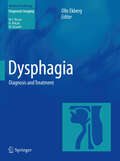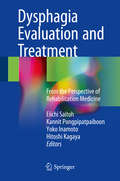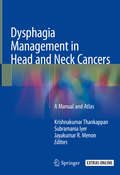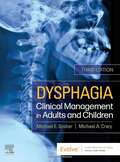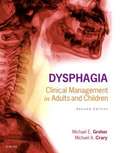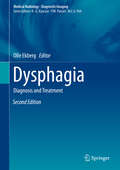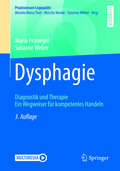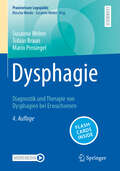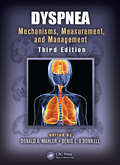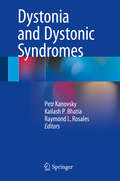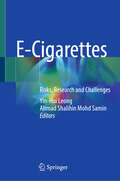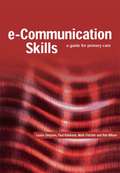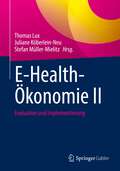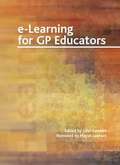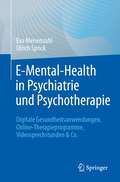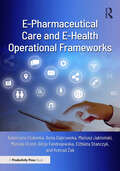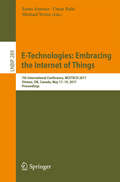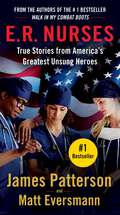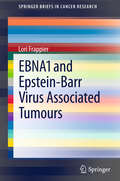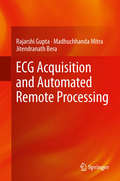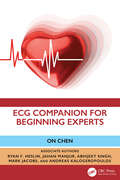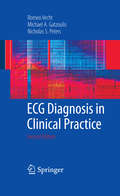- Table View
- List View
Dysphagia
by Olle EkbergThis book provides a comprehensive and up-to-date description of the diagnosis and management of dysphagia, with particular reference to oral and pharyngeal dysfunction. All aspects of dysphagia are covered, from anatomy and physiology to patient care. Alongside descriptions of a variety of disease entities, signs and symptoms, and treatment approaches, many other relevant topics are addressed, including endoscopic and manometric aspects, malnutrition and dehydration, the psychiatric burden, and features specific to pediatric and geriatric patients. The authors are without exception renowned experts in their field. This book will be of value to all specialists involved in the evaluation and treatment of dysphagia, including ENT surgeons, thoracic surgeons, speech and language pathologists, phoniatricians, gastroenterologists, neurologists, and radiologists.
Dysphagia Evaluation and Treatment
by Eiichi Saitoh Kannit Pongpipatpaiboon Yoko Inamoto Hitoshi KagayaThis book presents a comprehensive approach to treating dysphagia that has been successfully applied in actual rehabilitation settings. Its main purposes are firstly to equip readers with a strong conceptual understanding of swallowing evaluation and treatment, secondly to provide guidance on the procedure of practical comprehensive dysphagia rehabilitation in real-world settings, and thirdly to update readers on the latest diagnostic and treatment technologies. To do so, it employs the concept of swallowing rehabilitation pioneered at Fujita Health University Rehabilitation. The book is divided into 4 major sections, the first of which introduces readers to the general aspects and the principle of deglutition. In turn, Part II offers clinical approaches to both non-instrumental and instrumental evaluation of swallowing. Part III addresses treatment options in swallowing rehabilitation, especially exercises based on motor learning. Lastly, Part IV highlights three clinical cases demonstrating clinical approaches in dysphagic patients. Readers will find this text useful both as an initial guide and a reference work for assisting clinicians, allowing them to further expand swallowing assessment and treatment, and facilitating the development of swallowing rehabilitation in real-world settings in education and rehabilitation.
Dysphagia Management in Head and Neck Cancers: A Manual and Atlas
by Krishnakumar Thankappan Subramania Iyer Jayakumar R MenonDysphagia and problems related to swallowing are common following treatment for head and neck cancers. Though there are books available on dysphagia management and associated neurological conditions, this is the only atlas that comprehensively discusses dysphagia related to the head and neck cancers. It comprises of 33 chapters divided into five sections. The initial chapters present the anatomy and physiology of swallowing and the pathophysiology of the dysphagia-related structures. It discusses assessment of dysphagia in detail, highlighting clinical and instrumental evaluations. Swallowing dysfunction related to common sub-site cancers and chemo-radiotherapy related dysphagia are explored individually. The book addresses direct and indirect swallowing therapy methods involving postures and exercises in a detailed yet simple manner to enable them to be incorporated in routine practice. It also covers topics like nutritional management, alternative feeding methods and unique problems associated with tracheostomy that have a great bearing on the day-to-day management of patients with dysphagia. The current status of the research and evidence- based management updates are also included. Additionally, where appropriate videos are included for a better understanding of the subject. Written and edited by experts in the field, the book is intended for clinicians treating head and neck cancer, head and neck surgeons, radiation oncologists, speech and swallowing therapy specialists and trainees in these fields
Dysphagia and Nutrition: The Meal of a Patient with Swallowing Disorders
by Antonio AmitranoThe book offers a comprehensive overview of deglutition disorders and of dysphagia treatment, presenting a review of the main instruments for evaluating and treating dysphagia. Swallowing difficulties are a growing concern in the general population, particularly in older patients. Deglutology, an emerging discipline that studies the physiopathological, diagnostic, and rehabilitative aspects of swallowing, is rapidly expanding in response to the increasing demand for clinical and rehabilitative interventions in this field. This book provides an updated presentation of the available diagnostic tools and rehabilitative treatments for dysphagia, offering a broad overview of the meanings that eating and meals hold in individual life. Based on the close relationship between food and quality of life, the concept of palliative nutrition is introduced, aiming to ensure the pleasure of eating and, along with it, attention to the non-nutritional aspects that food provides to individuals. This book will be of interest to professionals and academics specializing in deglutology, dysphagia treatment, and related disciplines, i.e. speech-language pathologists, physicians, nurses, researchers, and other healthcare professionals who are involved in the assessment and treatment of swallowing disorders. The translation was done with the help of artificial intelligence. A subsequent human revision was done primarily in terms of content.
Dysphagia: Clinical Management In Adults And Children
by Michael E. Groher Michael A. CraryMaster the evaluation and treatment of swallowing disorders! Dysphagia: Clinical Management in Adults and Children, 3rd Edition provides the information you need to diagnose and manage dysphagia in patients of all ages. Emphasizing evidence-based practice, this complete resource covers topics from esophageal disorders to respiratory and iatrogenic disorders. This edition adds a new Aging and Dysphagia chapterand is updated with the latest research and advances in dysphagia management. Written by speech-language pathology educators Michael E. Groher and Michael A. Crary, this guide helps you develop clinical reasoning skills and learn today’s best practices in dysphagia management.
Dysphagia: Clinical Management in Adults and Children
by Michael E. Groher Michael A. CraryGet all the information you need to confidently manage dysphagia in professional practice with Dysphagia: Clinical Management in Adults and Children, 2nd Edition! This logically organized, evidence-based resource reflects the latest advancements in dysphagia in an approachable and user-friendly manner to help you master the clinical evaluation and diagnostic decision-making processes. New coverage of the latest insights and research along with expanded information on infant and child swallowing will help prepare you for the conditions you'll face in the clinical setting. Plus, the realistic case scenarios and detailed review questions threaded throughout the book will help you develop the clinical reasoning skills needed for professional success.
Dysphagia: Diagnosis and Treatment (Medical Radiology)
by Olle EkbergThe second edition of this well-received book provides a comprehensive and up-to-date description of the diagnosis and management of dysphagia, including oral, pharyngeal, and esophageal dysfunction. All aspects of dysphagia are covered, with detailed consideration of anatomy, physiology, and pathology. In addition to a variety of benign and malignant disease entities, signs and symptoms, and treatment approaches, many other relevant topics are addressed, including endoscopy, manometry, malnutrition, dehydration, oral care, dementia, ethics, and the social and psychologic impacts of dysphagia. Specific aspects of importance in pediatric and geriatric patients are highlighted. This edition features a number of completely new chapters focusing on, among other subjects, dysphagia in further disease contexts and following laryngectomy and radiation therapy. The authors are without exception world-leading experts in their fields. The book will be of value for practitioners in all specialties involved in the evaluation and treatment of dysphagia. It is therefore a truly multidisciplinary project.
Dysphagie: Diagnostik Und Therapie - Ein Wegweiser Für Kompetentes Handeln (Praxiswissen Logopädie)
by Mario Prosiegel Susanne WeberDie Behandlung von Schluckstörungen stellt für Logopäden, Ärzte und Angehörige anderer Berufsgruppen eine besondere Herausforderung dar, weil die richtige therapeutische Vorgehensweise für Betroffene lebenswichtig sein kann. Dieses Buch vermittelt umfangreiches Wissen, um Dysphagien verschiedener Ursachen professionell unter interdisziplinären Gesichtspunkten behandeln zu können. Es ist gleichermaßen geeignet für Ausbildung, Berufseinstieg und Personen mit Vorkenntnissen.Erlangen Sie durch praxisnahes Wissen mehr Kompetenz und Sicherheit in der Dysphagie-Therapie.Inhalt: Anatomie und Physiologie des Schluckvorgangs, optimales Dysphagie-Management wie Leitsymptome, mit Schluckstörungen assoziierte Erkrankungen, Folgen von Dysphagien;Therapieplanung und Behandlung; Fallbeispiele zur Lernzielkontrolle; übersichtliche Darstellung von Übungen: kritisch beleuchtet hinsichtlich aktueller Studienergebnisse über deren Wirksamkeit; zahlreiche Exkurse zur thematischen VertiefungNeu in der 3. Auflage: vollständig überarbeitet, aktualisiert und erweitert; zahlreiche eindrucksvolle Videoendoskopie-Aufnahmen, Screeningverfahren zur Prophylaxe von Aspirationspneumonien; Algorithmus zur Ernährungsweise in der akuten Schlaganfallphase; Medizinische Begutachtung von Schluckstörungen; Zugriff auf Videos und Extra-Material zum Buch über die Springer Nature More Media AppIdeal für Akutmedizin, Rehabilitation und ambulante Versorgung!
Dysphagie: Diagnostik und Therapie von Dysphagien bei Erwachsenen (Praxiswissen Logopädie)
by Mario Prosiegel Susanne Weber Tobias BraunDieses Lehrbuch vermittelt umfangreiches Wissen für das professionelle Erkennen und Therapie von Dysphagien bei Erwachsenen verschiedenster Ursachen unter interdisziplinären Gesichtspunkten. Egal ob in der Ausbildung, im Studium, Berufsalltag oder bei Stellenwechsel: Hier erhalten Sie das notwendige Rüstzeug, um kompetente Entscheidungen bei der Behandlung von Schluckstörungen treffen zu können. Übungen, an Symptomen orientiert und wissenschaftlich belegt, bieten die Basis für eine gut begründete und effiziente Arbeit mit dysphagischen Menschen. Zahlreiche Exkurse, ein umfangreiches Literaturverzeichnis sowie digitales Zusatzmaterial ermöglichen die thematische Vertiefung.Neu in der 4. Auflage: Fallbeispiele und Fragen zur Lernkontrolle über die SN FlashCards. So können Sie digital an jedem Ort zu jeder Zeit Ihr Wissen überprüfen. Ein Standardwerk für (schluck)therapeutisches, ärztliches und pflegerisches Personal in der Akutmedizin, Rehabilitation und ambulanten Versorgung!
Dyspnea: Mechanisms, Measurement, and Management, Third Edition (Lung Biology In Health And Disease Ser. #Vol. 111)
by Donald Mahler Denis O'DonnellWith the high prevalence of chronic pulmonary diseases, including asthma, COPD, and interstitial lung disease, physicians need to recognize the cause of dyspnea and know how to treat it so that patients can cope effectively with this distressing symptom. Detailing recent developments and treatment methods, this revised and updated third edition of
Dystonia and Dystonic Syndromes
by Petr Kanovsky Kailash P. Bhatia Raymond L. RosalesThe current concept of dystonic movement connects the abnormal function of somatosensory pathways and somatosensory analyzers with the dystonic performance of motor action, which is based on the abnormality of sensorimotor integration. This concept is reflected not only in idiopathic dystonia, but also in secondary and symptomatic dystonias. This book will give a comprehensive account of the history of the terms dystonia and dystonic, the physiology of dystonic movement and the genetics and clinical appearance of primary and secondary dystonias. Taking into consideration latest research findings, Dystonia and Dystonic Syndromes offers an in-depth discussion of current treatment options available for dystonia, including pharmacotherapy, surgery and neurorehabilitation. Therefore, it serves as a valuable reference for practitioners in the fields of neurology, neurosurgery, psychiatry and neuroradiology as well as for neuroscientists.
Détoxification: Guérir, Renforcer, Lâcher prise
by Dr Angela FetznerLe grand livre de la désintoxication du corps et de l'esprit 400 pages d'informations expertes et prouvées. La désintoxication - c'est-à-dire l'élimination des substances nocives du corps - repose sur une longue tradition. De tout temps, les hommes ont ressenti le besoin de nettoyer leur corps et leur âme à intervalles réguliers et de les débarrasser de tout ce qui est superflu et nuisible. Les mesures de désintoxication servent surtout à mettre en marche les forces d'auto-guérison du corps. Ce livre décrit toutes les thérapies et méthodes de traitement naturelles qui se sont avérées efficaces pour une désintoxication fondamentale du corps et de l'esprit. Il s'agit de techniques efficaces, motivantes et praticables au quotidien pour se soigner soi-même. Vous trouverez toutes les mesures de désintoxication telles que la thérapie par les plantes médicinales, l'homéopathie, les sels de Schüßler, la purification spécifique des organes de désintoxication, les applications d'eau, les cataplasmes, la réduction du stress, le changement d'alimentation, etc. Avec l’aide des cures de désintoxication sélectionnées et présentées, vous ressentirez en peu de temps déjà plus de vitalité, de force et de joie de vivre. Le livre met également un terme aux demi-vérités et aux erreurs répandues par de nombreux profanes, par exemple sous la forme d'ebooks et de livres imprimés de moins de 50 pages, dont le contenu est au mieux inefficace et au pire très nuisible.
E-Cigarettes and the Comparative Politics of Harm Reduction: History, Evidence, and Policy
by Ronald Bayer Wayne Hall Virginia Berridge Amy L. FairchildThis open access book offers the first in-depth study of the history and current debates surrounding electronic cigarettes comparing the UK, US and Australia. Since their introduction, e-cigarettes have been the subject of much public, media and regulatory attention, with discussion centring on whether these devices encourage or discourage smoking. This study delves into the history of policymaking and institutions in three countries which have taken different approaches to the regulation of e-cigarettes. In the UK, the tradition of harm reduction through nicotine has helped form a response which has endorsed e-cigarettes, though not without considerable controversy. In contrast, the US has a cessation-only anti-tobacco agenda, and Australia has effectively banned e-cigarettes. This book argues that each country frames the long-term use of nicotine differently and prioritises the health of different groups within the population of smokers or non-smokers, set against a broad backdrop of national responses to addiction. By taking this comparative approach, the authors explore the relationship between history, evidence and policy in public health more widely.
E-Cigarettes: Risks, Research and Challenges
by Yin-Hui Leong Ahmad Shalihin Mohd SaminThis book provides an overview of the diverse effects of electronic cigarettes (vapes) on human health and their regulatory concerns. It includes a thorough examination of e-cigarettes, covering their historical evolution, chemical composition, metabolomic analysis, health effects, regulatory landscape, and the concerning issue of e-cigarette or vaping-associated lung illness (EVALI) through compelling case studies. As the e-cigarette market constantly evolves, introducing new e-liquid formulations, the book addresses the rising challenges in regulation and monitoring. It also answers critical questions and serves as a reference for e-cigarette researchers and its broader societal implications.This book contains concise practical insights for physicians, toxicologists, and chemists. It is also relevant for public health experts, policymakers, tobacco-dependence treatment providers, tobacco control advocates/activists, health educators, and enthusiasts alike.
E-Communication Skills: A Guide for Primary Care
by Simpson Louise Robinson Paul Fletcher Mark Wilson RobThis is a practical, easy-to-use, patient-centred approach to e-communication that can be read from cover to cover, or dipped into as a quick reference guide. It covers potential issues both internally (patients and practice) and externally (the primary care trust and the wider community) and considers both clinical and non-clinical settings and is also a very useful teaching resource. e-Communication Skills adopts the approach that communication is the responsibility of everyone in the primary care team, and helps everyone to play their part. This is an important book for healthcare professionals in primary care, including administrators and communications managers. It is also vital for healthcare e-organisations such as web based information services and networks, and policy makers and shapers.
E-Health-Ökonomie II: Evaluation und Implementierung
by Thomas Lux Stefan Müller-Mielitz Juliane Köberlein-NeuE-Health ist aus der Gesundheitsversorgung nicht mehr wegzudenken – das Digitale Versorgungsgesetz (DVG) auf politischer und die Gesundheits-App auf Rezept (DiGA) auf praktischer Ebene zeigen, dass die Digitalisierung im Gesundheitswesen Einzug gehalten hat.Immer stärker in den Fokus rücken nun ökonomische Betrachtungen und Analysen von E-Health. Dieses Buch gibt einen umfassenden Überblick über die Herausforderungen der Evaluation und Implementierung von E-Health-Anwendungen vor dem Hintergrund der aktuellen Diskussion und Entwicklung in Wissenschaft, Praxis sowie Politik. Dabei referenzieren die Beiträge von Wissenschaftlern und Branchenexperten weitestgehend auf ein standardisiertes Rahmenwerk zur Evaluation von E-Health und zeigen anhand konkreter Projekte praktische Vorgehensweisen sowie Chancen und Hürden der Implementierung auf. Sie liefern Einsichten und Argumente für die Diskussion um den gesundheitsökonomischen Nutzen und Mehrwert von Informationstechnologie in der Gesundheitswirtschaft.Praktiker und Wissenschaftler aus Medizin, Informatik und (Gesundheits-)Ökonomie sind genauso angesprochen wie alle weiteren Akteure, die sich mit der Ökonomie des Einsatzes von IT in der Gesundheitswirtschaft beschäftigen. Lehrenden und Studierenden gibt das Buch eine Übersicht zum aktuellen Stand der E-Health-Ökonomie.
E-Learning for GP Educators
by John Sandars Mayur Lakhani Dr. Ian BanksThis work includes a Foreword by Mayur Lakhani, Chairman of Council, Royal College of General Practitioners. General practitioners, as a widely dispersed group, are particularly reliant on e-learning. This book provides an overview of the topic and examines the past, present and future challenges, opportunities and benefits. With chapters devoted to creating a website, running short courses and standards and accreditation, this guide explores both vocational training and continuing professional development. It presents an evidence-based, practical approach for healthcare educators and practitioners with teaching responsibilities, course organisers and healthcare professionals with an interest in e-learning. "Excellent. Leading edge. As a practising GP I know just how hard it can be to keep up to date in a generalist discipline and showing progress. Having access to information is the straightforward bit - processing it and embedding it into clinical practice is the much bigger challenge as this book rightly points out. As a user of e-learning, I know how useful this technique can be if undertaken properly and to a defined standard. I have no doubt that this book will be a valuable contribution, creating an innovative learning culture and society in healthcare." - Mayur Lakhani, in his Foreword.
E-Mental-Health in Psychiatrie und Psychotherapie: Digitale Gesundheitsanwendungen, Online-Therapieprogramme, Videosprechstunden & Co
by Eva Meisenzahl Ulrich SprickDas Buch bietet einen Einblick in die Definition und Eigenschaften spezifischer digitaler Gesundheitsanwendungen (DiGAs) im Sektor Psychiatrie und Psychotherapie sowie die maßgeblichen Qualitätskriterien, die für Behandler und empfehlende Ärzte wichtig sind. Der Leser erfährt, welche digitalen Angebote es gibt und welche unterschiedlichen Formate genutzt werden können: Systematisch und präzise werden die verschiedenen, aktuell von Krankenkassen angebotenen digitalen Programme mit deren Einsatzgebieten vorgestellt. Ergänzt wird die Darstellung durch die wichtigen Themen der Kostenübernahmen, des Datenschutzes und der Sicherheit der Programme sowie die Wirksamkeit und Akzeptanz dieser modernen Verfahren.Darüber hinaus erläutern die Autoren das spezifische Konzept der Videosprechstunde und geben Hinweise zu dessen Abrechnungsformalitäten. Dieses hochaktuelle Kompendium ist für Psychiater, aber auch interessierte Ärzte anderer Fachrichtungen, Ärztliche Psychotherapeuten sowie Psychologen und Psychologische Psychotherapeuten sowie Fachpflege geeignet, um ihnen einen fachlichen und praktischen Überblick über dieses Themengebiet zu geben. Das Buch ist ein exzellenter Begleiter und zukünftiges „Must Have“ im Dickicht des modernen digitalen Zeitalters, wo sich der einzelne Behandler oft aus Zeitgründen in den unternehmerisch so wichtigen zukünftigen Themenbereichen nicht ausreichend informieren kann.
E-Pharmaceutical Care and E-Health Operational Frameworks
by Anna Dąbrowska Katarzyna Szalonka Alicja Fandrejewska Elżbieta Stańczyk Mariusz Jabłoński Mariola Drozd Konrad ŻakThis book aims to explore the potential of e- Health tools in revolutionizing healthcare services.Through an in-depth analysis, the authors showcase tools already functioning in the market and those expected to be implemented soon. Furthermore, the authors focus on e- Health tools that have yet to be adopted due to organizational and mental barriers on the part of their potential users, medical and pharmaceutical practitioners, patients and consumers. Drawing insights from surveys conducted among medical professionals, pharmaceutical staff and patients, the authors examine the awareness of medical practitioners and patients of the usability, necessity and benefits of these IT tools. It is important to indicate that no country has fully integrated e-Health systems into its healthcare infrastructure. Through their research, the authors present useful tools by analyzing the barriers that have hindered their implementation. This book also presents legal regulations aimed to establish systemic responsibilities for entities within the medical and pharmaceutical sectors and safeguard the sensitive data stored and processed within these systems. This book also explores cutting-edge technologies that ensure the safety of treatment and pharmacotherapy. These technologies empower healthcare providers to deliver interactive, health-promoting materials to patients based on the latest medical and pharmaceutical knowledge. By equipping patients with accurate information about their conditions and medication regimens, these tools mitigate the risks associated with misinformation sourced from unreliable outlets, thus fostering informed decision-making in healthcare. This book outlines a comprehensive model for synchronizing e-Health tools, designed to improve the quality of medical services by engaging all stakeholders in the healthcare ecosystem – including those involved in medical services, diagnostics, dietetics, physiotherapy and pharmacy. The data analysis includes the advantages and potential risks for healthcare providers and patients. Finally, this book aims to present a digitization model that would bring individual healthcare providers together, and as a result, improve the quality of services, reduce diagnosis times, and leverage artificial intelligence (AI)-based solutions for disease diagnosis.
E-Technologies: 7th International Conference, MCETECH 2017, Ottawa, ON, Canada, May 17-19, 2017, Proceedings (Lecture Notes in Business Information Processing #289)
by Esma Aïmeur, Umar Ruhi and Michael WeissThis book constitutes the refereed proceedings of the 7th International Conference on E-Technologies, MCETECH 2017, held in Ottawa, ON, Canada, in May 2017. This year’s conference drew special attention to the ever-increasing role of the Internet of Things (IoT); and the contributions span a variety of application domains such as e-Commerce, e-Health, e-Learning, and e-Justice, comprising research from models and architectures, methodology proposals, prototype implementations, and empirical validation of theoretical models. The 19 papers presented were carefully reviewed and selected from 48 submissions. They were organized in topical sections named: pervasive computing and smart applications; security, privacy and trust; process modeling and adaptation; data analytics and machine learning; and e-health and e-commerce.
E.R. Nurses: True Stories from America's Greatest Unsung Heroes
by James Patterson Matt EversmannJames Patterson and Matt Eversmann, #1 bestselling coauthors of Walk in My Combat Boots, powerfully present the medical frontline heroes who work to save our lives every day: E.R. Nurses. <p><p> Around the clock, across the country, these highly skilled and compassionate men and women sacrifice and struggle for us and our families. You have never heard their true stories. Not like this. From big-city and small-town hospitals. From behind the scenes. From the heart. This book will make you laugh, make you cry, make you understand. When we’re at our worst, E.R. nurses are at their best.
EBNA1 and Epstein-Barr Virus Associated Tumours
by Lori FrappierThis SpringerBrief is comprehensive account of the functions and effects of the Epstein-Barr virus (EBV) EBNA1 protein that relate to EBV-associated cancers and evidence for EBNA1 contributions to these cancers. EBNA1 was the first EBV protein detected and the most critical for EBV latent infection. EBNA1 fulfills multiple functions at EBV genomes which have been described in many (sometimes confusing) reports over the last 28 years. While these were initially thought to be the only roles of EBNA1, many reports in recent years have shown that EBNA1 also directly affects cellular processes in ways that would be expected to contribute to oncogenesis. However, the degree to which EBNA1 promotes cell survival and oncogenesis in various types of human tumours is not entirely clear and a matter of debate. This book offers a current synopsis of EBNA1 functions in EBV latency, including functions in DNA replication, mitotic segregation and transcription. Mechanisms of these EBNA1 functions is also discussed as well as implications for tumourigenesis. In addition, the cellular effects of EBNA1 will be reviewed, including how EBNA1 manipulates specific cellular proteins and relationships to EBV-associated lymphomas and carcinomas.
ECG Acquisition and Automated Remote Processing
by Rajarshi Gupta Madhuchhanda Mitra Jitendranath BeraThe book is focused on the area of remote processing of ECG in the context of telecardiology, an emerging area in the field of Biomedical Engineering Application. Considering the poor infrastructure and inadequate numbers of physicians in rural healthcare clinics in India and other developing nations, telemedicine services assume special importance. Telecardiology, a specialized area of telemedicine, is taken up in this book considering the importance of cardiac diseases, which is prevalent in the population under discussion. The main focus of this book is to discuss different aspects of ECG acquisition, its remote transmission and computerized ECG signal analysis for feature extraction. It also discusses ECG compression and application of standalone embedded systems, to develop a cost effective solution of a telecardiology system.
ECG Companion For Beginning Experts
by On ChenElectrocardiography (ECG) has existed in the medical field for over 100 years, but important concepts are still beyond the horizon for some trainees and physicians alike. This book occupies an unfilled niche, written for resident physicians across various specialties. Using a case-based format, it provides an analytical system that facilitates a high-yield interpretation, and by breaking down the 12-lead ECG using a simple system, the learner can quickly identify important findings. Thus, strengthening the knowledge of resident physicians, and facilitating better understanding and management of patients with abnormal ECGs—regardless of their career paths through the medical field.Key Features: Utilizes a two-pronged explanation style to facilitate learning where the first prong is the “what” of the ECG, and the second prong is the “why” and “how.” Focuses on high-yield abnormalities and clinical pearls, to enable those providers outside of the cardiology space to become more knowledgeable and confident when interpreting ECGs. Uses a built-in question bank to test and reinforce concepts learned in the primer and case studies.
ECG Diagnosis in Clinical Practice
by Michael A. Gatzoulis Romeo Vecht Nicholas PetersOver the last century the ECG has been used by clinicians to make major clinical decisions with regard to electric pacing, the use of thrombolytic drugs in acute myocardial infarction and the timing of surgery. In conjunction with a chest X-ray and the echocardiogram it is a fundamental part of the initial investigation of a patient with suspected heart disease. These electrical squiggles have always been difficult for students to understand. In part the problem has been that the formatting of the ECG has only become standard in the last two decades. Some important books have not provided the full twelve-lead ECG. On occasion the interpretation of the ECG has been related to complex explanations of the shapes of the electrical signals. For the practising physician much of the interpretation is a matter of pattern recognition.
